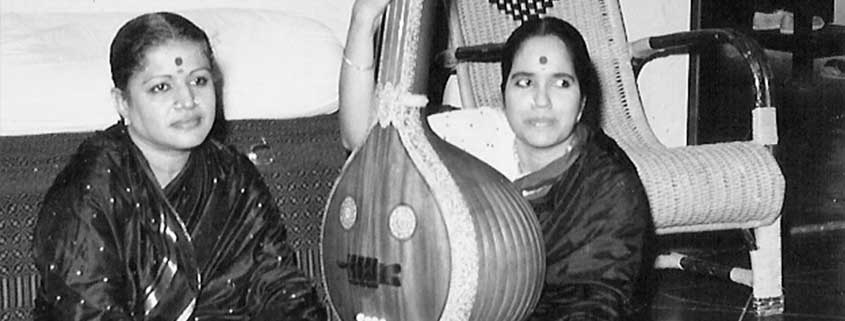Thangam Ananthnarayanan
Thangam Ananthnarayanan, Sadasivam’s brilliant niece, displayed her trademark incisive frankness in interactions with the many luminaries who visited the Sadasivams’ family home over the years. She just completed her 79th birthday. Her face lights up as she shares her memories of MS.
I used to call her Kunjakka just like her sister Vadivambal did. I first met her when I was around seven years old. Kunjakka was wearing a beautiful orange sari with a black border that had a kolam-like neli pattern. She was so beautiful, and wearing such pretty jewelry – diamond dolaku in her ears, a navaratnamala, as well as multiple gold chains. She was also wearing a brooch.
The children of the house would miss her so much when she was away filming for Seva Sadanam that we would cry. When this happened, Sadasivam Mama would take us to watch the movie being filmed. The director of the film, Subramaniam, would occasionally drive us all to Elliots Beach in his ‘open car’ (convertible). Crowds of people would flock to get a glimpse of Kunjakka on these trips.
Kunjakka used to enjoy listening to Roshanara Begum, Abdul Karim Khan, Kesar Bai . She used to enjoy a recording of Roshanara Begum singing Tilak Kamod and hum that.
When Siddeshwari Devi came and stayed at Kalki Gardens, they both used to do akaara sadhakam of various ragas and repeat the phrases 108 times. Siddeswari Devi would marvel at how Kunjakka effortlessly sang the brigas and the ‘alukkal’ sangatis.
The music room at Kalki Gardens had a lovely piano used by Piano Vaidyanathan when he composed the music for many songs (including Hari Tum Haro). I learnt to play it on my own and used to play various Hindustani ragas like Bhoop, Malkauns, and Sohini. Kunjakka would surprise me by suddenly coming into the room and giving me a hug and telling me how much she enjoyed my playing.
We used to have so much fun roaming the palace gardens at Udaipur during the filming of Meera. In the film, as Meera leaves the palace and heads towards Brindavan, she is caught in a storm and her tambura breaks. Kunjakka was inconsolable at the thought of the tambura—an instrument she held sacred—breaking, and wanted me to convey in English how strongly she felt about it to the director Ellis Dungan.
I also remember how mesmerized Kunjakka was by the Chittoor temple; she said how lucky she felt to have had the opportunity to sing in the temple built by the Rana for Meera herself.
Kunjakka’s sister Vadivambal played the veena very well. Vadiva used to also sing but her voice was much softer than Kunjakka’s. Brother Saktivel, dear to Kunjakka’s heart, played the mridangam.
Kunjakka’s mother would call her Rajaathi. I learnt to play Sivadeekshapuru (in Kurinji) on the veena by listening to a recording of Shanmukhavadivu. When she heard me playing it one day, Kunjakka was so moved.
Kunjakka’s favorite color was kili pachchai, parrot green. She loved animals, especially the cows at Kalki Gardens: Sita, Gowri, and Kaveri. She would go out to pet them every day.
I frequently accompanied Kunjakka to Kanchipuram when she sang for the Sivaratri pooja performed by Maha Periyava. Sometimes, Semmangudi Mama would also come. Both he and Kunjakka would sing from 6 pm to 6 am during the pooja. I used to nervously sing songs such as Gajavadana and Sambo Mahadeva with Kunjakka on the rare occasions that Radha did not come.
Once, when visiting the Palani temple, something unique happened. Kunjakka sat in the mandapam in front of the temple and sang many songs on Muruga. When she was singing Kaa Vaa Vaa, a beautiful peacock roaming the temple grounds, came and landed quite close to her. It then spread its fan and gently swayed to the music! Kunjakka was both overwhelmed and a little nervous that the bird had come so close! As soon as the song ended, the peacock flew away. Hearing Kunjakka that day was a thrilling experience for the devotees gathered there.



